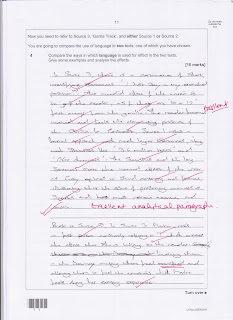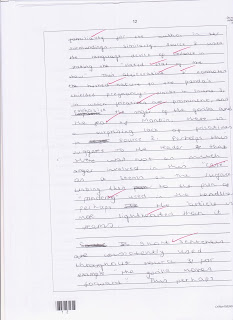I was mostly pleased with your mock responses to this question but there are still marks to pick up. What you ARE doing is identifying some language techniques, comparing the two sources using comparative vocabulary and commenting on the effects of the language techniques identified. However, you are not always fully exploring HOW or WHY the techniques are effective. Particularly, there is a need to go into explicit analysis of how vivid descriptive language is effective.
Below are some successful examples with a brief explanation as to why they are effective.
Aidan's opening paragraph:
This is a successful answer because it doesn't waste any time, gets straight down to making comments about language use. It also makes very clear comments about why and how a language technique is effective and does this in a reasonable amount of detail. The answer also compares with the other source as it goes and uses very clear comparatives in order to indicate to the examiner where this comparison comes in the answer.
Sophie's response
This is a successful answer because it also leaps straight into analysis: no time wasting. It also tends to reference a variety of techniques used and combines comments on their effect. This has the effect of making the answer seem particularly competent and authoritative because it packs in so much technical language analysis vocabulary. There is some quite detailed effect analysis, too which is something that some of you missed out on. Look at the analysis of the use of alliteration in Source 3, for example.
Ella's response:
Ella's response is successful because there are lots of examples of language techniques analysed and, unlike some of your responses, she does go into some explicit analysis of language EFFECT. Look particularly at the second page when she begins to discuss the effect of alliterative phrases in both sources. This is very detailed indeed and fulfils the marking criteria to be PERCEPTIVE for the top band.
The above response is a really clear example of how to answer this question. It is authoritative, full of comment on language, comparative throughout and detailed. The comments on how and why language use, particularly specific vivid words and phrases are perceptive and detailed. Read the whole thing.













